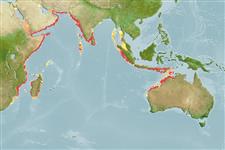Actinopterygii (ray-finned fishes) >
Lophiiformes (Anglerfishes) >
Antennariidae (Frogfishes) > Antennariinae
Etymology: Antennarius: From Latin, antenna, antemna = sensory organ (Ref. 45335). More on author: Schultz.
Environment / Climate / Range
Ecology
Marine; reef-associated. Tropical, preferred ?
Western Indian Ocean: East Africa, Gulf of Aden, and Seychelles to southeast India and Sri Lanka, north to the Gulf of Oman.
Size / Weight / Age
Maturity: Lm ? range ? - ? cm
Max length : 23.0 cm TL male/unsexed; (Ref. 9710)
An uncommon species that occurs to a depth of at least 25 m.
Life cycle and mating behavior
Maturity | Reproduction | Spawning | Eggs | Fecundity | Larvae
Oviparous.
Pietsch, T.W. and D.B. Grobecker, 1987. Frogfishes of the world. Systematics, zoogeography, and behavioral ecology. Stanford University Press, Stanford, California. 420 p. (Ref. 6773)
IUCN Red List Status (Ref. 115185)
CITES (Ref. 94142)
Not Evaluated
Threat to humans
Harmless
Human uses
More information
ReferencesAquacultureAquaculture profileStrainsGeneticsAllele frequenciesHeritabilityDiseasesProcessingMass conversion
Tools
Special reports
Download XML
Internet sources
Estimates of some properties based on models
Phylogenetic diversity index (Ref.
82805): PD
50 = 0.5005 [Uniqueness, from 0.5 = low to 2.0 = high].
Bayesian length-weight: a=0.01995 (0.00906 - 0.04395), b=3.01 (2.83 - 3.19), in cm Total Length, based on all LWR estimates for this body shape (Ref.
93245).
Trophic Level (Ref.
69278): 4.3 ±0.7 se; Based on size and trophs of closest relatives
Resilience (Ref.
69278): High, minimum population doubling time less than 15 months (Fec assumed to be > 10,000).
Vulnerability (Ref.
59153): Low vulnerability (12 of 100) .
